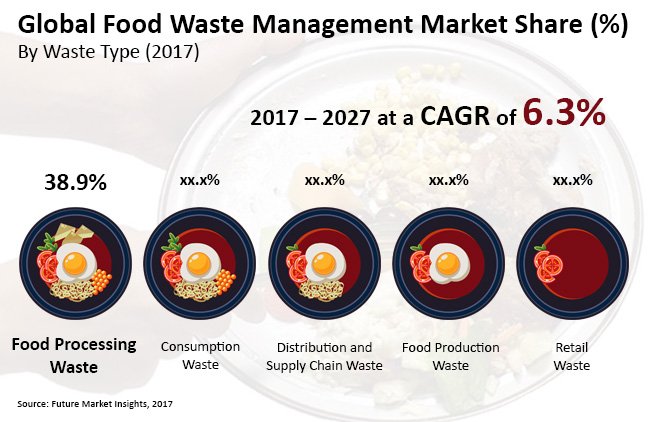Food processing waste includes waste generated from agricultural produce processing, poultry, meat, and seafood processing waste, dairy food processing waste, and waste from other types of food processing. Given the exponential growth of these sectors, the extent of generation of waste from these industries can only be imagined. This offers immense opportunities for key players operating in the global food waste management market to target the food processing waste segment in their business expansion and growth strategy.
Performance snapshot of the Waste Type segment
Future Market Insights analysis reveals that of the different types of wastes generated, waste from food processing is likely to beat the other segments to reach a market valuation in excess of US$ 35 Bn by the end of the forecast period in 2027. This reflects a CAGR of 6.8%. In terms of volume consumption, the food processing waste segment will touch about 182 Mn Tonnes by 2027, displaying a growth rate of 5.1%. The food processing waste segment is projected to rank relatively high on the market attractiveness index in the global food waste management market by 2027 end.
Following closely on the heels of the food processing waste segment is the consumption waste segment with revenues to the tune of almost US$ 30 Bn and a volume consumption of about 139 Mn Tonnes by the end of 2027. Growth rates in this segment are second in line to the food processing waste segment – recording a CAGR of 6.0% in terms of value and 4.4% in terms of volume during the forecast period 2017 – 2027.
These two segments – food processing waste and consumption waste – are likely to dominate the global food waste management market in terms of revenue share throughout the forecast period. The food processing waste segment is estimated to hold a value share of almost 39% in 2017 closely followed by the consumption waste segment at about 34%. The food processing waste segment will witness a massive increase of 210 basis points in its market share, while the consumption waste segment is anticipated to lose 90 basis points by the end of the forecast period. Revenue from the food processing waste segment is projected to increase at Y-o-Y growth rates ranging from 5.2% to 4.7% over 2017–2027.
While these two segments continue to witness good growth over the assessment period, revenue from the food production waste segment will witness a relatively low growth rate during the period 2017 – 2027. This segment will remain stagnant in terms of market share, holding just about 9% value share during the years 2017 as well as 2027.
Regulations governing the management of different types of food waste
It has been observed that food waste generation is relatively high in developed economies. An independent survey indicates that around 85% to 90% of the total food waste in developing countries is generated in the supply chain including producers, processors, distributors, transportation and logistics channels, and retailers. Governments of several countries are implementing stringent rules governing the effective management and disposal of food waste. Some cases in point:
Food Production Wastes: Regulatory bodies such as Food and Agriculture Organization (FAO) and Ministry of Agriculture, Forestry and Fisheries are regulating food waste management at the agricultural level in order to minimise food wastage at source.
Distribution and Supply Chain Wastes: The National Solid Waste Policy in Brazil focusses on increasing the sustainability of solid waste management and decreasing the total volume of waste produced at the national level. The sectors covered in the policy include healthcare, construction, transportation, forestry, mining, industrial, domestic, and public.
Consumption Wastes: The Macon-Bibb Commission has passed a law to privatise certain waste management services for garbage and yard waste within the city (residential) limits of the United States.
Retail Wastes: The Waste Management Legislation in Europe has made it mandatory for food manufacturers, service providers, and the retail sector to deal with food waste recycling and disposal in an environment friendly manner.
Request Sample Report











